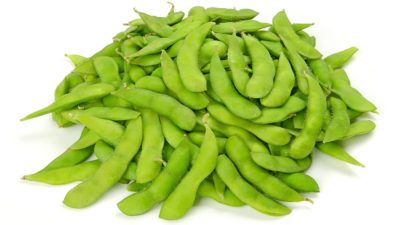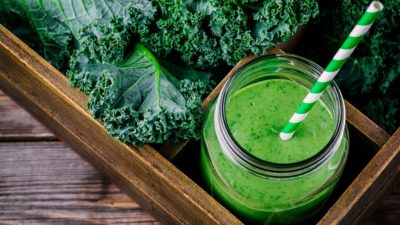Spinach

Spinach (Spinacia oleracea) is a leafy green plant native to central and western Asia. It is eaten as a vegetable – raw or cooked – and its leaves may be crinkled or smooth.
Overwhelming evidence shows that diets rich in fruit and vegetables are protective against common diseases, such as obesity, type 2 diabetes, heart disease and cancer. Leafy green vegetables, in particular, are recognised as offering substantial health benefits.
Like other leafy green vegetables, spinach contains very little fat and is packed with healthy nutrients. It is a good source of vitamins A (as beta-carotene), C and K, magnesium, manganese, iron and folate. It also provides B vitamins, vitamin E, calcium, potassium and fibre.
The iron myth
Spinach does provide iron but not at an extremely high level. A 90-gram portion of boiled spinach, for example, provides around two milligrams of iron. Women aged 19-50 need 14.8 milligrams a day and men (and women over 50) 8.7 milligrams a day.
The misconception that spinach is exceptionally high in iron can be traced back to a simple mathematical error when German chemist, Erich von Wolf, misplaced the decimal point when recording the iron content in spinach; making it seem 10 times higher than it really is! This caused the popular myth that cartoon character Popeye helped to spread even further. As part of a varied, vegan diet, spinach can boost your iron intake, but you need to include other iron-rich foods too.
Powerhouse of antioxidants
Studies show spinach has a protective role against certain cancers. This is probably because it is a powerhouse of antioxidants, responsible for many of the plant’s health benefits. Antioxidants prevent damage to our cells from unstable molecules called free radicals. If not kept in check, free radicals can lead to damage that in turn can lead to cancer and other degenerative diseases.
Eye health
Spinach contains powerful antioxidant compounds called lutein and zeaxanthin. They not only provide colour to plants but are also responsible for many of their health benefits, particularly to your eyes. These two pigments are found naturally in the macula, a part of the retina where all the light-sensitive cells are concentrated. They are thought to act as a shield, protecting the macula against blue light which could damage the cells. Luckily, we can get plenty of these pigments through diet.
Lutein and zeaxanthin are linked to a lower risk for cataracts and age-related macular degeneration. Spinach is also a good source of beta-carotene, which your body converts to vitamin A, essential for healthy eyesight. Spinach also provides copper and vitamin E; both help support eye health.

Metabolic syndrome
Metabolic syndrome is the term used for a combination of high blood pressure, high cholesterol, obesity and high blood sugar (insulin resistance). Having three or more of these conditions together is particularly dangerous as it increases the risk of diabetes, heart disease and stroke.
Leafy green vegetables, such as spinach, rocket and chard, have been shown to reduce the symptoms of metabolic syndrome. This is possibly because they contain bioactive compounds such as nitrates, fibre and flavonoids. Eating spinach as part of a healthy, varied vegan diet may help prevent some or all of these conditions.
Good for your brain
Some evidence suggests spinach may help slow cognitive decline and improve mood. The consumption of leafy green vegetables, including spinach, kale and lettuce, was linked to slower cognitive decline in one large study looking at older adults in the US. The rate of decline among those eating one to two servings a day was the equivalent of being 11 years younger compared with those who rarely or never consumed leafy green vegetables. The authors suggest this protective effect may be due to folate, vitamin K1 (phylloquinone) and lutein.
Research suggests that foods containing folate could also help improve mental health and lower the risk of anxiety and depression. The word folate is derived from the Latin word folium, which means leaf – giving a clue to where you can obtain this vitamin. One 90-gram serving of spinach provides 40 per cent of the daily 200 microgram recommended amount of folate.
Oxalic acid
Spinach contains relatively high levels of compounds called oxalates which are found in plants, animals and humans (our bodies produce it as waste). Levels in some green vegetables, like spinach and chard, are much higher than in others. Oxalates may increase the risk of kidney stones in some people and may also lower the absorption of minerals such as calcium.
However, oxalates are water soluble, so cooking (eg blanching or boiling) spinach can reduce the levels. If you’re prone to kidney stones or have kidney disease, your doctor may recommend you follow a low-oxalate diet. If you are worried about this, you can always substitute spinach for bok choy or kale.
Vitamin K
Along with spring greens and kale, spinach is a very rich source of vitamin K, which helps our blood clot. The name is derived from the German word, ‘koagulation’ (coagulation or blood clotting), which is essential for wound healing when we injure ourselves. Our blood needs to start clotting very quickly otherwise we might bleed to death.
Another important function of vitamin K is keeping our bones healthy and strong. Low levels have been associated with an increased risk of osteoporosis and arthritis. However, people taking blood thinners, such as Warfarin, should avoid consuming excessive amounts of spinach and other leafy green vegetables to avoid blunting the effect of their medication.
How to use spinach
Spinach can be used raw in salads (baby leaf spinach is best for this) or blended in smoothies. Cooked spinach is delicious in pasta dishes, such as lasagne, vegan (tofu) quiche, savoury tarts, with breakfast pancakes, added to tofu scramble or mixed into soups, stews and curries – especially dahl.
For most people, spinach is a healthy food that can be a useful addition to a varied, vegan diet. The key to good health is to eat a wide variety of fruit and vegetables.






